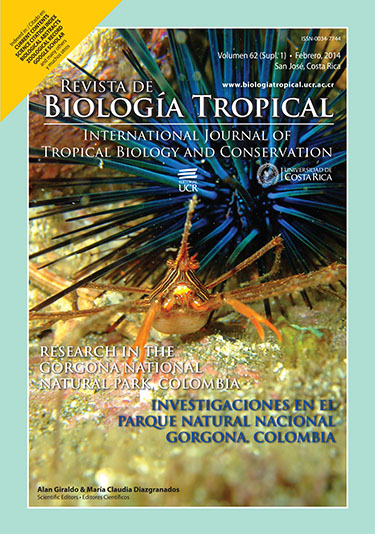Abstract
The National Natural Park Gorgona is a continental island off the Colombian Pacific coast. Bees have a specialized and crucial role in this isolated and unique ecosystem and here we assess their biodiversity. In three visits, at intervals of three months, six areas of the island with variable vegetation cover, were sampled. Sampling was done indirectly using (i) McPhail traps (baited with cineole, methyl silicate and clove oil), (ii) Van Someren Rydon traps (baited with rotting fish, chicken or fruit), (iii) Malaise traps and (iv) light traps. In addition, a direct sampling was carried out along transects of indeterminate length, for periods of one hour in each area and repeated four times. A total of 585 specimens was captured, of these 443 belong to Apidae (14 genera), 141 to Halictidae (six genera) and one Megachilidae. With this report the local inventory of bees rises to 43 species and 28 genera. Trigona fulviventris guianae Cockerell, 1910 was the most abundant species, Euglossa ignita, the most attracted to aromatic lures and Megalopta genalis Meade-Waldo, 1916 was the dominant species during evening hours. The absence of Apis mellifera was noticeable. Rev. Biol. Trop. 62 (Suppl. 1): 297-305. Epub 2014 February 01.
References
Baena, M. L. & Alberico, M. (1991). Relaciones biogeográficas de las hormigas de la Isla Gorgona. Revista Colombiana de Entomología, 17: 24-31.
Bonilla-Gómez, M. A. & Nates-Parra, G. (1992). Abejas euglosinas de Colombia (Hymenoptera: Apidae) I. Claves ilustradas. Caldasia, 17: 149-172.
Cantillo, E. E. & Sánchez, H. (2010). Características generales de las regiones naturales de Colombia con énfasis en vegetación. Obtenido de http://diplomadoincendiosforestales.net/es/node/6
Chapman, R. F. (1998). The insects: Structure and function. Fourth Edition. Cambridge University Press, United Kingdom.
Engel, M. S. (2010). Revision of the bee genus Chlerogella (Hymenoptera, Halictidae), Part II: South American species and generic diagnosis. Zookeys, 47: 1-100.
Engel, M. S. & Gonçalves, R. B. (2010). A revised key to the species of Caenaugochlora (Ctenaugochlora), with the description of a new species from Costa Rica (Hymenoptera: Apoidea: Augochlorini). Genus, 21: 101-110.
Giraldo, A. & Valencia, B. (2012). (Eds.). Isla Gorgona: Paraíso de biodiversidad y ciencia. Universidad del Valle, Cali, Colombia.
Gómez-Aguirre, A. M., Longo-Sánchez, M. C. & Blanco, J. F. (2009). Macroinvertebrate assemblages in Gorgona Island streams: spatial patterns during two contrasting hydrologic periods. Actualidades Biológicas, 31: 161-178.
González, V. H. & Engel, M. S. (2004). The tropical Andean bee fauna (Insecta: Hymenoptera: Apoidea), with examples from Colombia. Entomologische Abhandlungen, 62: 65-75.
González, V.H., González, M. M. & Cuéllar, Y. (2009) Notas biológicas y taxonómicas sobre los abejorros del maracuyá del género Xylocopa (Hymenoptera: Apidae, Xylocopini) en Colombia. Acta Biológica Colombiana, 14 (2): 31-40.
Gonzalez, V. H., Griswold, T. & Ayala, R. (2010). Two new species of nocturnal bees of the genus Megalopta (Hymenoptera: Halictidae) with keys to species. Revista de Biología Tropical, 58: 255-263.
Gonzalez, R., Montoya, J., Chacón de Ulloa, P., Zúñiga, M. C., Armbrecht, I., Carrejo, N., Posso, C. E., Torres, D. M., Valdés, S., Sarria, F., González, M., Calero, H., Mendivil, J. A. & Cardona, W. (2011). Protocolo para la obtención de datos de insectos. In A. Giraldo & X. Moreno (Eds.), Protocolos de investigación en ecosistemas terrestres, intermareales, submareales y pelágicos para el Parque Nacional Natural Gorgona (pp. 9-40). Universidad del Valle, Cali, Colombia.
Gonçalves, R. B. & Brandão, C. (2008). Diversidade de abelhas (Hymenoptera, Apidae) ao longo de uma gradiente latitudinal na Mata Atlântica. Biota Neotropica, 8: 51-61.
Goulson, D. (2003). Effects of introduced bees on native ecosystems. Annual Review of Ecology, Evolution and Systematics, 34: 1-26.
Hammer, Ø., Harper, D. A. T. & Ryan, P. D. (2001). PAST: Paleontological Statistics Software Package for Education and Data Analysis. Palaeontologia Electronica 4. Retrieved from http://www.nhm.uio.no/norlex/past/download.html
Hill, R.W. (1980). Fisiología animal comparada: Un enfoque ambiental. Editorial Reverté, Madrid, España.
Holdridge, L. R. (1967). Life zone ecology. Tropical Science Center. San José, Costa Rica.
Instituto de Ciencias Naturales, Facultad de Ciencias, Universidad Nacional de Colombia. (2004). Colección de invertebrados. Obtenido de http://www.biovirtual.unal.edu.co/ICN/
Kato, M., Shibata, A., Yasui, T. & Nagamasu, H. (1999). Impact of introduced honeybees, Apis mellifera, upon native bee communities in the Bonin (Ogasawara) islands. Researches on Population Ecology, 41: 217-228.
Michener, C. D. (2007). The bees of the world. Second Edition. The Johns Hopkins University Press, Baltimore, USA.
Nates-Parra, G. & González, V. H. (2000). Las abejas silvestres de Colombia: porqué y cómo conservarlas. Acta Biológica Colombiana, 5: 5-37.
Ospina, R. & Sandino, J. C. (1997). Eulaema chocoana, new euglossine bee species from the Pacific coast of Colombia. Caldasia, 19: 165-174.
Rasmussen, C. (2009). Diversity and abundance of orchid bees (Hymenoptera: Apidae, Euglossini) in a tropical rainforest succession. Neotropical Entomology, 38: 66-73.
Sandino, J. C. (1995). Primer inventario de abejas euglosinas (Hymenoptera: Apidae: Euglossinae) en la vertiente del pacífico del suroccidente de Colombia: Diversidad, distribución altitudinal y efectos de la perturbación humana (Tesis de grado). Universidad del Valle, Cali, Colombia.
Sarmiento, C. E. (2003). (Ed.). Insectos. Instituto Alexander von Humboldt, Boletín del proyecto Diversidad de insectos de Colombia 5. Obtenido de http://www.humboldt.org.co/humboldt/homeFiles/ inventarios/boletin_2.pdf
Smith-Pardo, A. & González, V. H. (2007). Diversidad de abejas (Hymenoptera: Apoidea) en estados sucesionales del bosque húmedo tropical. Acta Biológica Colombiana, 12: 43-56.
Vélez-Ruiz, R. E. (2009). Una aproximación a la sistemática de las abejas silvestres de Colombia (Tesis de Maestría). Universidad Nacional de Colombia, Medellín, Colombia.
##plugins.facebook.comentarios##

This work is licensed under a Creative Commons Attribution 4.0 International License.
Copyright (c) 2014 Revista de Biología Tropical


